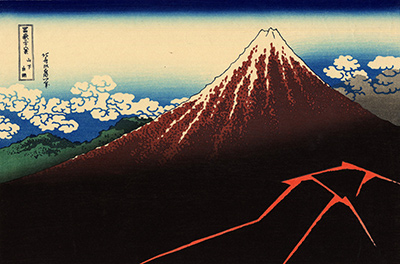Hokusai
Rainstorm Beneath the Summit by Hokusai
Rainstorm Beneath the Summit is one of the prints that puts the huge mountain fully in the foreground, its snowy cap just above the thunder clouds. Harsh, jagged lines of lightening play down towards the bottom right of the picture and the bright, light sky above the peak contrasts sharply with the darkness of the lower slopes.
When one compares this image to David Hockney’s Weather Series, it is easy to see the influence of Hokusai on this most modern of artists and to appreciate the Japanese master’s legacy. Katsushika Hokusai has become one of the most influential artists of Japan, inspiring such famous painters as Van Gogh, Manet and, more recently, David Hockney. He is known, in particular, for his woodblock prints. Hokusai studied art with a well-known Ukiyo-e teacher but went on to develop and mature his own style, producing work of great breadth and variety. The term Ukiyo-e means Pictures of the floating world, and is associated with the fleeting, worldly pleasures of ordinary people.
Hokusai was a master of the woodblock printing technique which developed in Japan throughout the 1700s. Each print was produced by first making a drawing and then reproducing it as a carving in a wooden block. The block was then coated in ink and applied to paper to produce the print. For every colour used, a new block would be needed and Hokusai used a lot of colours. When Hokusai was 70 years old and at the peak of his career, he began work on a series of woodblock prints.
Each print depicted a different view or perspective of the iconic Japanese volcano; Mount Fuji. These prints became known as Thirty-six Views of Mount Fuji (although Hokusai added another ten at a later date). The most famous of this series is The Great Wave off Kanagawa but the other pictures in the series are of equal interest, even if they are not as well known. Hokusai has brilliantly captured a single moment when the forces of nature have dramatically changed the view of any onlooker.
